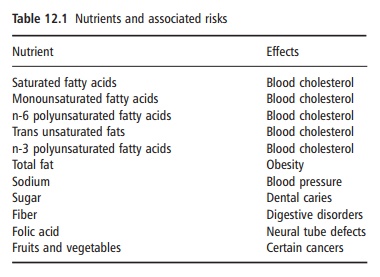Chapter: Introduction to Human Nutrition: Food and Nutrition: Policy and Regulatory Issues
Reference points in human nutrition
Reference points in human
nutrition
Prevailing dietary habits, as measured through dietary surveys,
represent the first reference point for nutrition policy. The second set of
reference points are those targets set out by expert committees that will move
populations toward ever-healthier diets. All definitions employ the term
“reference” and hence they can be classified as reference nutritional data.
Such data were historically developed to ensure the adequacy of the human diet
from the point of view of micronutrients. However, as our knowledge of diet and
chronic disease has evolved, a second set of reference nutrition values had to
be developed, this time to minimize the risk of chronic disease. Table 12.1
shows a non-exhaustive list of these nutrients and the risk factor or chronic
disease they are associated with.

In addition to these data, recommendations are made for ideal
body weight and there are specific sets of dietary guidelines for such life
stages as lactation, pregnancy, aging, etc. However, the regulatory
environment in nutrition is dominated by the above nutrients and also the
micronutrients.
The whole purpose of devising these two sets of metrics –
nutrient intakes and nutrient reference values – is to first measure where we
are in relation to our nutritional well-being and second to set targets to move
the population toward a healthier diet. There is however, a very slight
antagonism between the establishment of an ideal pattern of nutrient intake and
developing public health nutrition programs to achieve that goal. The reason is
that the former does so in isolation from the real world of everyday eating.
Its focus is on experimental studies that, for example, help delineate the
optimal balance of dietary fatty acids to minimize plasma cholesterol. That
optimal may be very significantly different from prevailing dietary habits and
to attempt to bridge the gap too fast might produce a public health nutrition
program that is unrealistic. Thus nutritionists can look at pre-vailing intakes
against ideal intakes and then set out interim attainable targets in realistic
public health nutrition programs that can be implemented over a defined and
reasonable period of time. In summary, it is not possible to develop a
meaningful nutrition regulatory framework without access to both nutrient
intake data and dietary reference data.
Related Topics